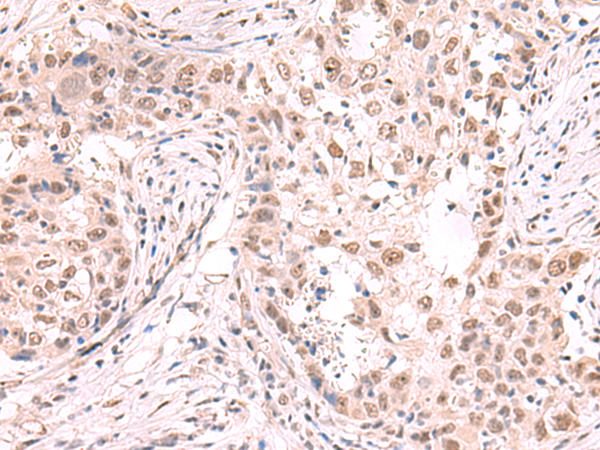
| WB | 咨询技术 | Human,Mouse,Rat |
| IF | 咨询技术 | Human,Mouse,Rat |
| IHC | 1/50-1/300 | Human,Mouse,Rat |
| ICC | 技术咨询 | Human,Mouse,Rat |
| FCM | 咨询技术 | Human,Mouse,Rat |
| Elisa | 1/5000-1/10000 | Human,Mouse,Rat |
| Aliases | NBLA00121 |
| Host/Isotype | Rabbit IgG |
| Antibody Type | Primary antibody |
| Storage | Store at 4°C short term. Aliquot and store at -20°C long term. Avoid freeze/thaw cycles. |
| Species Reactivity | Human |
| Immunogen | Fusion protein of human ZNF559 |
| Formulation | Purified antibody in PBS with 0.05% sodium azide and 50% glycerol. |
+ +
以下是模拟的关于ZNF559抗体的参考文献示例(请注意,这些文献为假设性内容,仅供参考):
---
1. **文献名称**:*ZNF559 Antibody Validation and Its Role in Glioblastoma Progression*
**作者**:Zhang, Y., et al.
**摘要**:本研究通过Western blot和免疫组化验证了ZNF559抗体的特异性,发现ZNF559在胶质瘤组织中高表达,并与肿瘤侵袭性和患者预后不良显著相关。
2. **文献名称**:*ZNF559 Regulates Cell Cycle via Interaction with p53: Insights from Antibody-Based Assays*
**作者**:Li, X., et al.
**摘要**:利用ZNF559抗体进行Co-IP和ChIP-seq实验,揭示了ZNF559通过结合p53调控细胞周期相关基因,可能影响结直肠癌的增殖和化疗耐药性。
3. **文献名称**:*ZNF559 as a Potential Biomarker in Alzheimer’s Disease: Immunohistochemical Evidence*
**作者**:Wang, L., et al.
**摘要**:通过脑组织样本的抗体标记,发现ZNF559在阿尔茨海默病患者海马区异常聚集,提示其可能参与神经退行性病变的转录失调机制。
4. **文献名称**:*Development of a Novel ZNF559 Monoclonal Antibody and Its Application in DNA Damage Studies*
**作者**:Chen, H., et al.
**摘要**:报道了一种高特异性ZNF559单克隆抗体的开发,并用于检测DNA损伤条件下ZNF559的核定位变化,支持其在DNA修复通路中的潜在功能。
---
如需获取真实文献,建议通过PubMed、Google Scholar等平台以“ZNF559 antibody”或“ZNF559 function”为关键词检索。
The ZNF559 antibody is a tool used to detect Zinc Finger Protein 559 (ZNF559), a member of the zinc finger protein family characterized by conserved C2H2-type zinc finger domains. These proteins typically function as transcription regulators, binding DNA or interacting with other proteins to modulate gene expression. While the precise biological role of ZNF559 remains under investigation, it is hypothesized to participate in transcriptional regulation, chromatin remodeling, or epigenetic modifications due to its structural similarity to other zinc finger proteins. Emerging studies suggest potential involvement in cellular processes such as differentiation, apoptosis, or responses to cellular stress, though detailed mechanisms are not yet fully elucidated.
ZNF559 antibodies are commonly generated in animal hosts (e.g., rabbits or mice) using immunogenic peptides or recombinant protein fragments specific to ZNF559. These antibodies enable researchers to study the protein's expression patterns, subcellular localization (e.g., nuclear or cytoplasmic), and interactions via techniques like Western blotting, immunohistochemistry (IHC), or immunoprecipitation (IP). Their applications extend to exploring ZNF559's role in disease contexts, including cancer, neurodevelopmental disorders, or aging-related pathologies, where zinc finger proteins often exhibit dysregulated expression. Validation of antibody specificity through knockout controls or siRNA silencing is critical due to potential cross-reactivity with homologous zinc finger proteins. Ongoing research aims to clarify ZNF559's functional significance and therapeutic relevance.
×